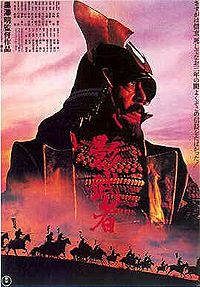|
|||
|
Philatelia.Net / Pirates. Bandits. Adventurers / Plots / The directory «Plots»«Kagemusha» (影武者)«Kagemusha» is a 1980 film by Akira Kurosawa. The title (which literally translates to "Shadow Warrior" in Japanese) is a term used for an impersonator. It is set in the Warring States era of Japanese history and tells the story of a lower-class criminal who is taught to impersonate a dying warlord in order to dissuade opposing lords from attacking the newly vulnerable clan. The warlord whom the kagemusha impersonates is based on daimyo Takeda Shingen and the climactic 1575 Battle of Nagashino. The film opens with a shot of what appears to be three identical Shingens. One really is Shingen, the second is his brother, Nobukado. The third man is a thief who Nobukado accidentally came across and spared from crucifixion, believing the thief's uncanny resemblance to Shingen would prove useful. Shingen agrees that he would prove useful as a double and they decide to use the thief as a kagemusha. Shingen's army has besieged a castle of Tokugawa Ieyasu. When Shingen visits the battlefield to hear a mysterious nightly flute player, he is shot by a sniper. Mortally wounded, he orders his generals to keep his death a secret for three years. Shingen later dies while being carried over a mountain pass, with only a small group of witnesses. Nobukado presents the thief to the generals and contrives a plan to have this kagemusha impersonate Shingen full-time. At first, even the thief is unaware of Shingen's death, until he tries to break into a huge jar, believing it to contain treasure, and instead finds Shingen's preserved corpse. After this act, the generals decide they cannot trust the thief and set him free. The Takeda leaders secretly dump the jar with Shingen's corpse into Lake Suwa. Spies working for Tokugawa and his ally, Oda Nobunaga witness the disposal of the jar, and suspect that Shingen has died and go to report the death. The thief, however, overhearing the spies, goes to offer his services hoping to be of some use to Shingen in death. The Takeda clan preserves the cover-up by saying they were making an offering of sake to the god of the lake. The spies follow the Takeda army as they march home from the siege. Although they suspect that Shingen has died, they are later convinced by the kagemusha's performance. Returning home, the kagemusha successfully fools Shingen's concubines and grandson. By imitating Shingen's gestures and learning more about him, the kagemusha begins to take on the persona of Shingen, and is able to awe even the bodyguards and wakashu who knew Shingen best. When he must preside over a clan council, and is unexpectedly asked for his decision on a military matter, he cleverly relies on the clan motto, which identifies Shingen with an unmoving mountain. When Tokugawa and Oda Nobunaga launch an attack against Takeda territory. Shingen's son, Katsuyori, launches a counterattack against the advice of other generals. The kagemusha is forced to lead reinforcements to the Battle of Takatenjin, and helps inspire the troops to victory. In a fit of overconfidence, the kagemusha attempts to ride Shingen's spirited horse. When he falls off those who rush to help him see that he does not have their lord's battle scars and he is revealed as an impostor. The thief is driven out of the palace, and Katsuyori, despite being disinherited, takes over the clan. In full control of the Takeda army, Katsuyori leads an ill-advised attack against Oda Nobunaga, who controls Kyoto, resulting in the Battle of Nagashino. Wave after wave of cavalry and infantry are cut down by volleys of matchlock fire, effectively wiping out the Takeda. During this scene, much of the battle is offscreen. Although the charge of the Takeda army and the volley of fire from Nobunaga's soldiers is seen, the actual deaths of the Takeda men is not shown until the battle is over and the viewer sees a vast scene of carnage as more time is given to the aftermath. (In reality, the clan continued under Katsuyori's leadership for years after the battle). The kagemusha, who has followed the Takeda army, witnesses the slaughter. In a final show of loyalty, he takes up a lance and makes a futile charge against Oda's fortifications, ultimately dying for the Takeda clan. The final image is of the kagemusha's bullet-riddled body being washed away down a river, next to the flag of the Takeda clan.Guinea, 2008, «Kagemusha», «Taxi Driver» Advertising: |
|||
© 2003-2025 Dmitry Karasyuk. Idea, preparation, drawing up
|

